Chronic Myelogenous Leukemia
Chronic myelogenous leukemia (CML) is a clonal myeloproliferative disorder resulting from the neoplastic transformation of the primitive hematopoietic stem cell. The disease is monoclonal in origin, affecting myeloid, monocytic, erythroid, megakaryocytic, B-cell, and, sometimes, T-cell lineages. Bone marrow stromal cells are not involved.
Chronic myelogenous leukemia (CML) is a clonal myeloproliferative disorder resulting from the neoplastic transformation of the primitive hematopoietic stem cell. The disease is monoclonal in origin, affecting myeloid, monocytic, erythroid, megakaryocytic, B-cell, and, sometimes, T-cell lineages. Bone marrow stromal cells are not involved.
CML accounts for 15% of all leukemias in adults. Approximately 4,500 new cases of CML will be diagnosed in 2007, and it is estimated that 600 patients will die of CML this year. The incidence is 1.7 per 100,000 population. With imatinib (Gleevec) therapy, the annual mortality may be reduced significantly (less than 2%–3% per year).
Epidemiology
Gender The male-to-female ratio is 1.1–1.4:1.
Age According to SEER (Surveillance, Epidemiology, and End Results) and MRC (Medical Research Council, UK) data, the median age of patients with CML is 66 years. However, most patients who are admitted to chemotherapy studies are 50–60 years old, with a median age of ~53 years. Patients in bone marrow transplantation (BMT) studies are even younger, with a median age of ~40 years. Age differences must be considered in all studies because this variable may affect results.
Etiology and risk factors
The etiology of CML is unclear. Some associations with genetic and environmental factors have been reported, but in most cases, no such factors can be identified.
Genetic factors There is little evidence linking genetic factors to CML. Offspring of parents with CML do not have a higher incidence of CML than the general population.
Environmental factors Nuclear and radiation exposures, including therapeutic radiation, have been associated with the development of CML. Exposure to chemicals has not been associated with greater risk except for the use of benzene.
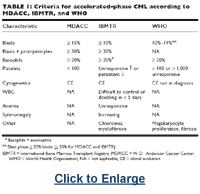
Signs and symptoms
CML usually runs a biphasic or triphasic course. This process includes an initial chronic phase and a terminal blastic phase, which is preceded by an accelerated phase in 60%–80% of patients.
Chronic phase If untreated, chronic-phase CML is associated with a median interval of 3.5–5.0 years before transforming to the more aggressive phases leading to death. During the chronic phase, CML is asymptomatic in
15%–40% of all cases and, in these cases, is discovered on a routine blood examination.
In symptomatic patients, the most common presenting signs and symptoms are fatigue, left upper quadrant pain or mass, weight loss, and palpable splenomegaly. Occasionally, patients with very high WBC counts may have manifestations of hyperviscosity, including priapism, tinnitus, stupor, visual changes from retinal hemorrhages, and cerebrovascular accidents.
Patients in chronic-phase CML do not have an increased risk for infection. Splenomegaly is documented in 30%–70% of patients. The liver is enlarged in 10%–20% of cases.
Accelerated phase This is an ill-defined transitional phase. The criteria (M. D. Anderson Cancer Center [MDACC]) used recently in all the imatinib studies include the presence of ≥ 15% blasts, ≥ 30% blasts and promyelocytes, or ≥ 20% basophils in the peripheral blood or a platelet count < 100 × 109/L unrelated to therapy. Cytogenetic clonal evolution is also a criterion for acceleration. Other classifications include more subjective criteria (Table 1). The classification used may affect the expected outcome for a group of patients defined as accelerated phase. With imatinib therapy, the estimated 4-year survival rate exceeds 50%. Thus, a new definition of accelerated phase (ie, predictive for short survival) needs to be developed.
The accelerated phase is frequently symptomatic, including the development of fever, night sweats, weight loss, and progressive splenomegaly.
Blastic phase The blastic phase morphologically resembles acute leukemia. Its diagnosis requires the presence of at least 30% of blasts in the bone marrow or peripheral blood. The World Health Organization has proposed to consider blast phase with ≥ 20% blasts, but this classification has not been validated, and recent evidence suggests that patients with 20% to 29% blasts have a significantly better prognosis than those with ≥ 30% blasts. In some patients, the blastic phase is characterized by extramedullary deposits of leukemic cells, most frequently in the CNS, lymph nodes, skin, or bones.

Patients in blastic phase usually die within 3–6 months. Approximately 70% of patients in blastic phase have a myeloid phenotype; 25%, lymphoid; and 5%, undifferentiated. Prognosis is slightly better for patients with a lymphoid blastic phase than for myeloid or undifferentiated cases (median survival 9 vs 3 months).
Patients in blastic phase are more likely to experience symptoms, including weight loss, fever, night sweats, and bone pain. Symptoms of anemia, infectious complications, and bleeding are common. Subcutaneous nodules or hemorrhagic tender skin lesions, lymphadenopathy, and signs of CNS leukemia may also occur.
Laboratory features
Peripheral blood The most common feature of CML is an elevated WBC count, usually > 25 × 109/L and frequently > 100 × 109/L, occasionally with cyclic variations. The finding of unexplained, persistent leukocytosis (eg, > 12–15 × 109/L) in the absence of infections or other causes of WBC count elevation should prompt a work-up for CML.
The WBC differential usually shows granulocytes in all stages of maturation, from blasts to mature, morphologically normal granulocytes. Basophils are elevated, but only 10%–15% of patients have ≥ 7% basophils in the peripheral blood. Frequently, eosinophils are also mildly increased. The absolute lymphocyte count is elevated at the expense of T lymphocytes.
The platelet count is elevated in 30%–50% of patients and is higher than 1,000 × 109/L in a small percentage of patients with CML. When thrombocytopenia occurs, it usually signals disease acceleration.
Some patients have mild anemia at diagnosis.
Neutrophil function is usually normal or only mildly impaired, but natural killer (NK) cell activity is impaired. Platelet function is frequently abnormal but usually has no clinical significance.
Bone marrow The bone marrow is hypercellular, with cellularity of 75%–90%. The myeloid-to-erythroid ratio is usually 10–30:1. All stages of maturation of the WBC series are usually seen, but the myelocyte predominates.
Megakaryocytes are increased in number early in the disease and may show dysplastic features. They are usually smaller than the typical normal megakaryocytes. Fibrosis may be evident at diagnosis but increases with disease progression and is usually an adverse prognostic finding.
Other laboratory findings Leukocyte alkaline phosphatase activity is reduced at diagnosis. Serum levels of vitamin B12 and transcobalamin are increased, sometimes up to 10 times normal values. Serum levels of uric acid and lactic dehydrogenase (LDH) are also frequently elevated.
Cytogenetic and molecular findings
Philadelphia chromosome CML is characterized by the Philadelphia (Ph) chromosome, which represents a balanced translocation between the long arms of chromosomes 9 and 22, t(9;22)(q34;q11). The c-abl proto-oncogene located in chromosome 9q34 encodes for a nonreceptor protein-tyrosine kinase expressed in most mammalian cells. In chromosome 22, the breakpoint occurs within the BCR gene and usually involves an area known as the breakpoint cluster region major (m-bcr), located either between exons b3 and b4 or between exons b2 and b3. Therefore, two different fusion genes can be formed, both of them joining exon 2 of abl with either exon 2 (b2a2) or exon 3 of bcr (b3a2). Among the 5% to 10% of patients who do not have the Ph chromosome detected by karyotyping, 30% to 40% have the molecular rearrangement identified by fluorescent in situ hybridization (FISH)/polymerase chain reaction (PCR). Those patients without this rearrangement are considered to have atypical CML and have a different prognosis and treatment.
Upon translation, a new protein with a molecular weight of 210 kd (p210BCR-ABL) is synthesized, which, compared with the normal c-abl, has markedly increased kinase activity and can transform transfected cells and induce leukemia in transgenic mice. Occasionally, the breakpoint can occur in other areas (m-bcr and µ-bcr), leading to different transcripts (eg, p190BCR-ABL and p230BCR-ABL, respectively). The mechanism of oncogenesis of p210BCR-ABL is unclear, but, upon phosphorylation, it can activate several intracellular pathways, including ras and the MAP kinase pathway, the Jak-Stat pathway, the PI3 kinase pathway, and the myc pathway. Ultimately, this leads to altered adhesion to extracellular matrix and stroma, constitutive activation of mitogenic signals, and inhibition of apoptosis.
Staging and prognosis
Staging systems Several characteristics of CML, including age; spleen size; WBC and platelet counts; and percentage of blasts, eosinophils, and basophils in the peripheral blood, affect the prognosis. Deletions of the derivative chromosome 9 are identified in 10% to 15% of patients and have been associated with an adverse prognosis with most treatment modalities. Imatinib may overcome the adverse prognosis associated with del der(9), although this remains controversial. These factors have been incorporated into several staging systems.
Sokal’s classification A frequently used risk classification is Sokal’s prognostic risk system. In this system, the hazard ratio function is derived from the following formula: λi(+)/λo(t) = Exp 0.0116 (age – 43.4) + 0.0345 (spleen – 7.51) + 0.188 [(platelets/700)2 – 0.563] + 0.0887 (blasts – 2.10).
This risk classification defines three prognostic groups with hazard ratios of < 0.8, 0.8.–1.2, and > 1.2.
The Hasford classification has been suggested to separate more clearly and without overlap risk groups among patients treated with interferon therapy. The Hasford score is derived from the formula (0.6666 × age [0 when age < 50 years; 1, otherwise] + 0.0420 × spleen size [cm below costal margin] + 0.0584 × blasts [%] + 0.0413 × eosinophils [%] + 0.2039 × basophils [0 when basophils < 3%; 1, otherwise] + 1.0956 × platelet count [0 when platelet count < 1,500 × 109/L; 1, otherwise]) × 1000. Based on the score, patients can be classified into three risk groups: low (score ≤ 780), intermediate (score > 780 and ≤ 1480), and high (≥ 1480). This classification may be less predictive in the imatinib era. In an analogous fashion, patients who might be candidates for transplantation can be assessed using the European Bone Marrow Transplant (EBMT) score.
Treatment
CHRONIC PHASE
Conventional chemotherapy
Busulfan (Busulfex, Myleran) and hydroxyurea were the chemotherapeutic agents used most frequently in CML until the development of imatinib. Busulfan is usually given at a dose of 0.1 mg/kg/d until the WBC count decreases by 50%, at which point the dose is reduced by 50%. Therapy is discontinued when the WBC count drops below 20 × 109/L and is restarted when it rises above 50 × 109/L.
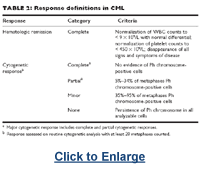
Busulfan is associated with lung, marrow, and heart fibrosis and can cause an Addison-like disease. In 10% of patients, prolonged myelosuppression may be observed.
Hydroxyurea has a lower toxicity profile than does busulfan. The usual dose of hydroxyurea is 40 mg/kg/d; this dose is reduced by 50% when the WBC count drops below 20 × 109/L. The dose is then adjusted individually to keep the WBC count between 2 and 8 × 109/L.
Both busulfan and hydroxyurea can control the hematologic manifestations of CML in more than 80% of patients, although hydroxyurea results in a longer duration of chronic phase and overall survival than does busulfan. Neither drug significantly reduces the percentage of cells bearing the Ph chromosome, and, therefore, transformation to the blastic phase is unchanged. Their use should be limited to temporary control of hematologic manifestations before definitive therapy (eg, imatinib, stem-cell transplantation) is instituted.
Interferon
Recombinant interferon (rIFN-α) can induce a complete hematologic response (Table 2) in 70%–80% of patients with CML, with some degree of suppression of Ph chromosome-positive cells (referred to as a cytogenetic response) in 40%–60% of patients, which is complete in up to 20%–25% of patients. Randomized studies have documented a survival advantage for patients treated with rIFN-α vs those treated with chemotherapy.
In patients who achieve complete cytogenetic responses, they are durable in ≥ 80% of cases. Patients who achieve a complete cytogenetic response have a 10-year survival rate of 75% or more.
Interferon and cytarabine (Ara-C) The combination of IFN-α and low-dose Ara-C has induced major cytogenetic responses in 40%–50% of patients. Two randomized trials confirmed an improved response rate with this combination compared with rIFN-α alone, and one of them also demonstrated a survival advantage. The response to rIFN-α is dose-dependent, and the recommended dose is 5 × 106 U/m2/d. However, higher doses are also associated with increased toxicity, and at least 30% of patients will require dose reductions and/or discontinuation of therapy because of toxicity.
A recent long-term follow-up analysis has confirmed that a fraction of patients (approximately 30% of those achieving complete cytogenetic remission) treated with IFN-α in early chronic phase may achieve a sustained molecular remission and are probably cured. Among the others, 40% to 60% remain free of disease after more than 10 years despite the presence of minimal residual disease. This has been called “operational cure.”
New formulations of rIFN-α attached to polyethylene glycol (PEG-IFN) have a longer half-life that allows for weekly administration. It may also be associated with decreased toxicity, allowing for increased dose intensity, but has shown no therapeutic advantage.
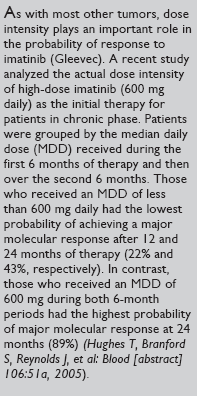
Imatinib is a potent inhibitor of the tyrosine kinase activity of bcr-abl and a few other tyrosine kinases, such as PDGF-R (platelet-derived growth factor-receptor) and c-kit. It has demonstrated significant activity in patients with CML in all phases of the disease, whether they have received prior therapy or not. Among patients with chronic-phase CML for whom prior IFN-α therapy failed, 55%–85% of patients achieved a major cytogenetic remission, including 45%–80% with a complete cytogenetic remission. The estimated rate of survival free of transformation to accelerated with blast phase is 69% at 60 months. Among patients treated in early chronic-phase CML who had not received prior therapy, the rate of complete cytogenetic response is 85%–90%, with an overall survival rate at 54 months of 93%, and survival-free of transformation, 93%.
In a randomized trial, imatinib was significantly superior to IFN-α plus Ara-C in hematologic, cytogenetic, and molecular responses and disease progression-free survival, as well as toxicity profile and quality of life. Because of a high rate of crossover from IFN-α to imatinib, there was no difference in overall survival. However, comparisons with historic controls treated with IFN-α have shown the expected survival benefit with imatinib therapy. Thus, imatinib has become the standard therapy for CML (Figure 1). The proper management of patients receiving imatinib is important.
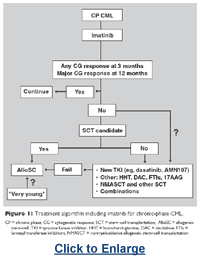
Dose The standard dose of imatinib is 400 mg daily for chronic phase and 600 mg for accelerated and blastic phases. Dose reductions may be needed in some patients because of toxicity, but doses less than 300 mg daily are not recommended. Available data from the phase I study show a clear decrease in the probability of response with doses lower than 300 mg daily. Several studies have suggested that starting therapy for patients in chronic phase with a higher dose of imatinib (600 or 800 mg daily) may improve the rate of complete cytogenetic and molecular responses with adequate tolerance. A randomized trial is currently ongoing to address whether the standard dose should be changed.
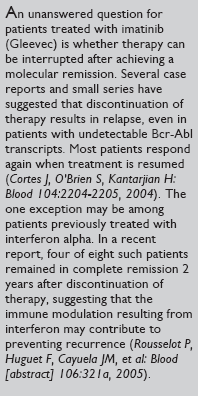
Toxicity Imatinib is well tolerated. However, a significant fraction of patients develop grade 1–2 adverse events, including nausea, peripheral or periorbital edema, muscle cramps, diarrhea, skin rashes, weight gain, and fatigue. These events frequently are minor and either do not require therapy or respond to adequate early intervention. Fluid retention responds to diuretics when indicated; diarrhea can be managed with loperamide or other agents; nausea usually responds to prochlorperazine, promethazine, or other agents; muscle cramps can be managed with tonic water or quinine; skin rash may be managed with antihistamines and/or corticosteroids (topical and/or systemic).
Myelosuppression is the most common grade 3–4 adverse event. Neutropenia can be seen in up to 45% of patients, thrombocytopenia in up to 25% of patients, and anemia in 10% of patients. Treatment is held for grade ≥ 3 neutropenia (neutrophil count < 109/L) or thrombocytopenia (platelet count < 50 × 109/L) and restarted when counts recover above these levels. If the recovery takes longer than 2 weeks, the dose may be reduced. Treatment interruptions and dose reductions are not usually recommended for anemia. Myelosuppression is much more likely to occur during the first 2 to 3 months of therapy and is best managed with treatment interruption and close monitoring. Hematopoietic growth factors (granulocyte colony-stimulating factor [G-CSF, filgrastim, Neupogen] and erythropoietin) have been used successfully to manage prolonged or recurrent myelosuppression.
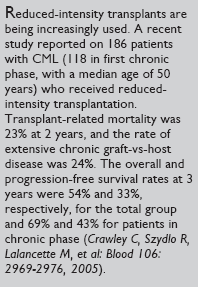
Monitoring The treatment objective has evolved from hematologic responses (hydroxyurea) to cytogenetic responses (IFN-α), to molecular responses in the imatinib era. All patients have to be evaluated with cytogenetic analysis before the start of therapy, and a baseline quantitative PCR analysis is useful. Conventional cytogenetic analysis is important at baseline and for follow-up because it provides valuable information about the entire karyotype (ie, clonal evolution, cytogenetic abnormalities in Ph chromosome-negative cells) that cannot be obtained with FISH or PCR and has prognostic implications. A cytogenetic analysis every 3 to 6 months during the first year and every 6 to 12 months thereafter is recommended. Quantitative PCR is recommended every 3 to 6 months. It is inappropriate not to follow patients with cytogenetic and molecular analyses.
Duration of therapy At this time, the duration of therapy is unclear. A minority of patients have reached undetectable levels of disease by PCR, and few have discontinued therapy. This has usually resulted in relapse. Thus, until further evidence becomes available, patients should continue therapy indefinitely.
Patients who have at least a minor cytogenetic response after 3 to 12 months of therapy still have a 35%–50% probability of achieving a complete cytogenetic response with continuation of therapy. Thus, these patients should continue therapy unless a more effective, low-risk option is available. Patients who fail to respond or lose their response to therapy may improve with an increased dose of imatinib. Up to 50% of patients may improve their cytogenetic response by doubling the dose from 300 or 400 mg to 600 or 800 mg daily.
Allogeneic BMT
Allogeneic BMT is potentially curative in CML, although relapses and mortality for complications such as chronic graft-vs-host disease (GVHD) may occur many years after transplantation. Results are better for patients in the chronic phase than in either the accelerated or blastic phase. Long-term survival rates of 50%–80% and disease-free survival rates of 30%–70% can be achieved in the chronic phase. The role of BMT is now changing in view of the results obtained with imatinib.
Predictors of response Early BMT within the first 1–3 years after diagnosis may be associated with a better outcome than BMT later in the course of disease. Younger patients also have a better outcome than older patients, with those younger than age 20 to 30 having the best prognosis. The use of the EBMT score helps to separate those patients who may have a better outcome from those who will not.
Conditioning regimens, including total-body irradiation (TBI), have been traditionally used, but non–TBI-containing regimens (eg, with busulfan and cyclophosphamide [Cytoxan, Neosar]) have produced similar results. More recently, conditioning regimens using pharmacologic targeting of busulfan have been associated with decreased regimen-related toxicity while preserving the antileukemia effect.
Also, nonmyeloablative conditioning regimens frequently containing purine analogs (mini-BMT) have been tested recently to expand the use of transplants to older patients or to patients with medical conditions that preclude conventional BMT.
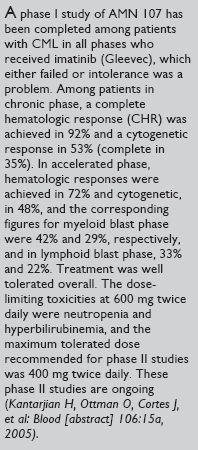
Graft-vs-host disease The major morbidity from BMT is GVHD. T-cell depletion of the graft can reduce the incidence of this complication but at the expense of higher relapse and graft failure rates. (For a full discussion of GVHD, see chapter 36.)
Alternatives to matched-related donors For patients who do not have a matched-related donor, matched unrelated donor (MUD) transplants are reasonable alternatives. The 9-year experience from the National Marrow Donor Program in 1,432 patients reported a 3-year survival rate of 37.5%. Early transplantation results in better outcome, with patients transplanted in chronic phase having a 3-year disease-free survival of 63%. The outcome of patients transplanted in accelerated, blastic, or second chronic phase is inferior.
Relapse after BMT Donor leukocyte infusions are the most effective strategy to treat patients who relapse after BMT. With this strategy, 70%–80% of patients can achieve a cytogenetic complete response; the best results are achieved when patients are treated during cytogenetic or molecular relapse. Imatinib has also been effective for patients who relapse after BMT. A complete hematologic response in > 70% of patients and a cytogenetic response in 58% have been reported, with the best responses obtained in patients relapsing in chronic phase.
Autologous BMT
Although 40%–70% of patients can achieve some degree of suppression of Ph chromosome-positive cells upon engraftment of the autologous transplant, this result is usually short-lived, and most patients relapse within 1 year. Some patients previously refractory to
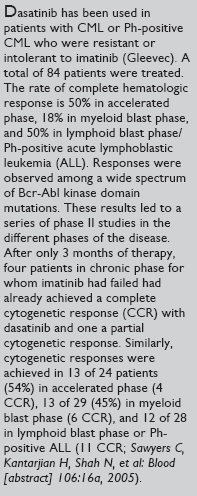
rIFN-α may regain sensitivity after autologous BMT. The role of autologous BMT with cells collected after complete response to imatinib and with imatinib-based therapy after transplantation is currently being investigated.
Treatment recommendations
No compatible related donor Most patients (> 70%) do not have a related HLA-compatible donor. With the approval of imatinib for first-line therapy in CML, it should be considered standard for these patients.
Matched-related or one-antigen-mismatched donor When allogeneic bone marrow from a matched-related (or one-antigen-mismatched) donor is available, it could be considered as the initial option when the 1-year transplant-related mortality is expected to be < 20%. The impressive results with imatinib are changing this algorithm, and it is currently recommended to use imatinib as first-line therapy for all patients. The use of higher doses of imatinib should be considered. If no cytogenetic response is achieved after 6 months of therapy or no major cytogenetic response is seen after 12 months, transplantation can be considered in younger patients with available donors.
MUD Transplant-related mortality is > 20% in most cases. Therefore, it is recommended that imatinib be used for patients who have only an unrelated donor available and whose expected transplant-related mortality is > 20%. MUD BMT should be considered for patients who do not respond to imatinib therapy if they have a full match and their expected mortality is < 40%.
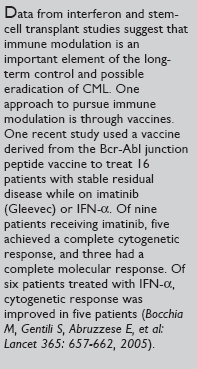
Imatinib failure When to consider failure to imatinib is still a matter of debate. However, most patients will achieve a hematologic response to imatinib within 3 months and a major cytogenetic response by 12 months. Patients not achieving any cytogenetic response after 6 months of therapy have a low probability (less than 15%) of later achieving a complete response. In contrast, patients having at least a minor cytogenetic response at 6 or 12 months still have a 20%–50% probability of achieving a complete cytogenetic response with continuation therapy. Increasing the dose of imatinib (eg, from 400 mg/d to 800 mg/d) may result in a major cytogenetic response in ∼40% of patients. Patients in whom imatinib fails to induce a response and who are not candidates for BMT should be offered investigational options. Agents currently being investigated alone or in combination with imatinib include second-generation tyrosine kinase inhibitors, decitabine, homoharringtonine (HHT), and farnesyl transferase inhibitors. Among them, the new tyrosine kinase inhibitors, such as AMN107 and BMS-354825 (dasatinib) are particularly attractive. AMN107 was designed based on the imatinib structure with modifications to improve its binding to BCR-ABL and increase its selectivity; these modifications result in an agent at least one order of magnitude more potent than imatinib against BCR-ABL. Dasatinib is structurally unrelated to imatinib and, in contrast to it, can bind both the inactive and active configurations of BCR-ABL. In addition, dasatinib is a dual inhibitor that blocks Src as well as Abl and is two orders of magnitude more potent than imatinib. Both agents have been shown to inhibit both the wildtype BCR-ABL and nearly all of the clinically significant mutants of Bcr-Abl, except for T315I. The results from the early clinical trials have been impressive.
The most frequently identified mechanism of resistance to imatinib is the development of mutations at the Abl kinase domain. Mutations are identified in 30% to 50% of patients, with the most frequent occurring in the P loop. Not all mutations confer the same level of resistance to imatinib, and some may be overcome by increased concentrations of imatinib. The most resistant mutation is T315I. Although P-loop mutations have been reported to be linked to a poor prognosis, this theory has not been confirmed in all studies and it is probably more appropriate to consider individual mutations rather than “families.”
Changing therapy based on molecular responses cannot be justified in most instances at the present time. Even when patients who have not achieved a 3-log reduction in transcript levels after 12 months of therapy have an inferior prognosis compared with those with at least a 3-log reduction, they still have a 92% probability of disease progression-free survival at 3 years, and in most instances, this only represents a loss of cytogenetic response. If the proposed alternative treatment option has any significant risk of mortality, the risk may be unnecessary. The clinical significance of the presence of mutations is still unclear. For example, the poor prognosis proposed for patients with P-loop mutations has not been confirmed by some groups. Thus, it is not clear that changes in therapy should be recommended based on the presence of mutations alone. However, in most instances, mutations are identifed in the context of clinical evidence of failure. In this instance, change in treatment strategy is indicated.
ACCELERATED AND BLASTIC PHASES
Imatinib
Imatinib is also effective for patients with CML in transformation. Seventy-one percent of patients in accelerated phase treated with 600 mg/d of imatinib had a hematologic response. The major cytogenetic response rate was 24%, with a time to disease progression of 12 months at 67%. These results are significantly superior to those with 400 mg/d, making 600 mg/d the standard dose in accelerated phase. In blast phase, 52% of patients achieved a hematologic remission and 31% a sustained remission lasting at least 4 weeks with imatinib. However, the median response duration is only 10 months, even when considering only patients with sustained remission (ie, lasting at least 4 weeks). Patients with clonal evolution have a lower probability of response and shorter survival than patients without clonal evolution when treated with imatinib.
Chemotherapy
Intensive chemotherapy regimens, including high-dose Ara-C and daunorubicin, induce remissions in only 25%–35% of patients in accelerated or blast phase (median survival durations of 8–18 months and 3 months, respectively). However, patients with a lymphoid blastic phase treated with therapy similar to that given for acute lymphocytic leukemia (ie, vincristine, doxorubicin, and dexamethasone, with or without cyclophosphamide) have a complete response rate of 60%–80%. Preliminary observations suggest that imatinib can be safely combined with chemotherapy regimens and may improve the duration of remission. Early results are encouraging, but long-term follow-up is pending.
A recent study combined HCVAD (cyclophosphamide, vincristine, Adriamycin [doxorubicin], and dexamethasone), a regimen used for acute lymphoblastic leukemia (ALL), with imatinib to treat 20 patients with Ph-positive ALL. All 15 patients with active disease achieved a complete response. Of 10 patients who subsequently received BMT, 9 remained in complete remission after a median follow-up of 12 months. Of the 10 patients ineligible for BMT, 1 relapsed after 1 year, 2 older patients died in complete remission, and all others remained in complete remission after a median of 20 months. This study suggests that the addition of imatinib to combination chemotherapy regimens used for ALL is well tolerated and may improve the results of patients with Ph chromosome-positive ALL.
New agents and combination regimens (eg, decitabine, cyclophosphamide, Ara-C, farnesyl transferase inhibitors, and second-generation tyrosine kinase inhibitors) are currently being evaluated. The best results have been obtained with the new tyrosine kinase inhibitors dasatinib and AMN107.
Decitabine is a hypomethylating agent with promising activity in patients in accelerated or blast phase. Decitabine has achieved an objective response in 33% of patients in blast phase and 66% of those in accelerated phase. Lower doses of decitabine achieve optimal demethylation with reduced toxicity and are currently being evaluated.
BMT
Compared with those results in patients in chronic phase, results with allogeneic BMT are worse in patients in accelerated or blastic phase, with 4-year survival rates of only 10%–30%. Patients in accelerated phase (determined on the basis of clonal evolution only) who undergo BMT < 1 year after diagnosis have a 4-year probability of survival of 74%.
SUGGESTED READING
Bocchia M, Gentili S, Abruzzese E, et al: Effect of a p210 multipeptide vaccine associated with imatinib or interferon in patients with chronic myeloid leukaemia and peristent residual disease: A multicentre observational trial. Lancet 365:657–662, 2005.
Branford S, Rudzki Z, Parkinson I, et al: Real-time quantitative PCR analysis can be used as a primary screen to identify patients with CML treated with imatinib who have BCR-ABL kinase domain mutations. Blood 104:2926–2932, 2004.
Cortes J, Giles F, O’Brien S, et al: Result of high-dose imatinib mesylate in patients with Philadelphia chromosome-positive chronic myeloid leukemia after failure of interferon-α. Blood 102:83–86, 2003.
Cortes JE, Talpaz M, Giles F, et al: Prognostic significance of cytogenetic clonal evolution in patients with chronic myelogenous leukemia on imatinib mesylate therapy. Blood 101:3794–3800, 2003.
Cortes J, Talpaz M, O’Brien S, et al: Molecular responses in patients with chronic myelogenous leukemia in chronic phase treated with imatinib mesylate. Clin Cancer Res 11:3425–3432, 2005.
Hughes TP, Kaeda J, Branford S, et al: Frequency of major molecular responses to imatinib or interferon alfa plus cytarabine in newly diagnosed chronic myeloid leukemia. N Engl J Med 349:1423–1432, 2003.
Kantarjian HM, Cortes JE, O’Brien S, et al: Imatinib mesylate therapy in newly diagnosed patients with Philadelphia chromosome-positive chronic myelogenous leukemia: High incidence of early complete and major cytogenetic responses. Blood 101:97–100, 2003.
Kantarjian HM, Cortes JE, O’Brien S, et al: Long-term survival benefit and improved complete cytogenetic and molecular response rates with imatinib mesylate in Philadelphia chromosome-positive chronic-phase chronic myeloid leukemia after failure of interferon-alpha. Blood 104:1979–1988, 2004.
Kantarjian HM, O’Brien S, Cortes J, et al: Imatinib mesylate therapy improves survival in patients with newly diagnosed Philadelphia chromosome-positive chronic myelogenous leukemia in the chronic phase: Comparison with historic data. Cancer 98:2636–2642, 2003.
Kantarjian HM, Talpaz M, O’Brien S, et al: Dose escalation of imatinib mesylate can overcome resistance to standard-dose therapy in patients with chronic myelogenous leukemia. Blood 101:473–475, 2003.
Kantarjian H, Talpaz M, O’Brien S, et al: High-dose imatinib mesylate therapy in newly diagnosed Philadelphia chromosome-positive chronic phase chronic myeloid leukemia. Blood 103:2873–2878, 2004.
Kantarjian H, Talpaz M, O’Brien S, et al: Prediction of initial cytogenetic response for subsequent major and complete cytogenetic response to imatinib mesylate therapy in patients with Philadelphia chromosome-positive chronic myelogenous leukemia. Cancer 97:2225–2228, 2003.
Kantarjian H, Talpaz M, O’Brien S, et al: Survival benefit with imatinib mesylate therapy in patients with accelerated-phase chronic myelogenous leukemia: Comparison with historic experience. Cancer 103:2099–2108, 2005.
Radich JP, Gooley T, Bensinger W, et al: HLA-matched related hematopoietic cell transplantation for chronic-phase CML using a targeted busulfan and cyclophosphamide preparative regimen. Blood 102:31–35, 2003.
Rosti G, Martinelli G, Bassi S, et al: Molecular response to imatinib in late chronic-phase chronic myeloid leukemia. Blood 103:2284–2290, 2004.
Shah NP, Tran C, Lee FY, et al: Overrriding imatinib resistance with a novel ABL kinase inhibitor. Science 305:399–401, 2004.